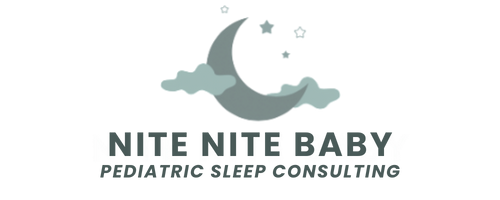🙇🏼♀️ Do Sleep Regressions Ever End? What’s Really Going On + How to Get Through It
As an Amazon Creator & Amazon Affiliate, I may earn commissions on qualifying purchases. Thank you for supporting my Blog ꨄ︎
✨ INTRO
If you’ve ever hit a stride with your baby’s sleep only to suddenly find yourself back at square one—hello hourly wakeups, skipped naps, or bedtime meltdowns—you’re not alone. These frustrating phases are often called sleep regressions, and while they can feel never-ending, they’re actually signs that progress is happening beneath the surface.
Let’s break down what each stage typically looks like, why it happens, and what you can do to support better sleep through it all.
READ: Why I Give Away a Free Sleep Plan Every Month (And How to Enter)
🌙 The 4-Month Sleep Regression
The first major regression—and often the most dramatic—happens around 4 months. This isn’t just a phase... it’s a biological shift.
Your baby is no longer a newborn and has developed a circadian rhythm (their internal clock), which means they’re more sensitive to light and noise. They may suddenly start struggling to fall asleep in bright or loud environments or only nap when held.
What You Can Do:
This is a critical window to build strong sleep habits. It’s the ideal time to begin sleep training (if that’s your goal), as many babies at this age haven’t yet formed strong sleep associations like needing to be fed or rocked to sleep. And if those associations are already forming, it’s much easier to change them now than later.
Creating a sleep-conducive environment can make all the difference:
✅ Pitch dark room ➡️These are the most affordable/Prime eligible blackout curtains that are actually amazing quality. I highly recommend. I also use these blackout stickers for the little lights on her baby monitor. You’d be surprised how a little tiny green light will keep your baby awake.
✅ White noise machine ➡️ One of our favorite sleep tools is the Hatch Rest+. I love that I can control everything from the app on my phone — especially in the mornings. We’ve created a little routine for my daughter where the Hatch plays cheerful birdie sounds and glows with soft rainbow lights to let her know it’s time to wake up. She gets so excited when she hears her “birdies” — it’s become a sweet part of how we start our day together. They have a Hatch Baby Sleep Bundle too that comes with both a travel sound machine & the one for your child’s room!
✅ Temp between 68–72°F
✅ Wearable sleep sacks ➡️ These Amazon Sleep Sacks are my absolute FAV’s.. I personally feel like they’re are Woolino dupes—but they’re $25 vs. $125. They’re so warm, they come in multiple TOG ratings, lot’s of cute colors/patterns, and the sizes they offer range from 0-6 months all the way up to 4T.
🐻 The 6-Month Regression
At 6 months, your baby is learning new skills like sitting, rolling, and beginning solids. Their brain and body are working overtime, and it can lead to disrupted naps or frequent night waking’s—especially if they’re practicing skills in their crib.
If you’ve laid a strong sleep foundation, this phase may pass quickly. If not, it’s still a great time to teach independent sleep.
🧠 The 8–10 Month Regression
Crawling, pulling up, and separation anxiety can all hit during this window. Your baby may:
Wake more frequently
Fight naps
Seem more clingy at bedtime
📅 This is often the time to extend wake windows or reassess your baby’s schedule.
🗣️ The 12-Month Regression
Your baby might start resisting naps or waking early, but don’t drop to one nap too soon. Most babies aren’t ready to consolidate to a single nap until 15–18 months.
💥 The 18-Month Regression
Language leaps, emotional development, and renewed separation anxiety often lead to bedtime resistance or night waking.
Stay consistent. Stick to your routines and gently hold boundaries.
😩 The 2-Year Regression
Between potty training, crib-to-bed transitions, and asserting independence, sleep can get rocky again around 24 months. Unlike earlier regressions, this one is more behavioral than biological.
So… Do Sleep Regressions Ever End?
Yes—and no.
Regressions are normal and often signal development, not dysfunction. But when your baby or toddler has the skills to fall asleep and return to sleep independently, these phases are:
Shorter
Less disruptive
Easier to recover from
🧭 Is It a Regression—or a Schedule Problem?
Here are common signs it’s time to adjust your baby’s schedule:
Suddenly short naps
Early morning wakeups
Fighting naps or bedtime
💤 Nap Transitions by Age:
4 to 3 naps → ~3–4 months
3 to 2 naps → ~6–7 months
2 to 1 nap → ~13–18 months
1 to no nap → ~3–4 years
📩 Want Help with Wake Windows & Nap Transitions?
Get my free download below: The Better Sleep Blueprint — includes wake window charts, sleep needs by age, and real-life tips to navigate regressions with confidence.
Need Personalized Support?
If you feel like you’ve tried everything and nothing is helping, let’s talk.
Book a free 15-minute call and we’ll see if there’s something deeper contributing to the sleep disruptions—and how I can help.
👉 My Calendar📅

